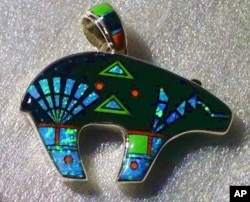Many Native American artists are quitting their trade because they cannot compete with the low prices of fake artwork.
William Woody is the top law enforcement official at the Fish and Wildlife Service. He said that possibly as much as 80 percent of Native American art is actually not made by Native Americans. Instead it is made in countries like the Philippines.
Woody said it is difficult to confirm how much art is fake, but Native Americans artists are concerned. They have called on the United States government to take action against people who produce fake artwork.
U.S. Senators from New Mexico, Tom Udall and Martin Heinrich, heard evidence from Native American artists earlier on July 7. Udall is the vice chairman of the Senate Committee on Indian Affairs.
Harvey Pratt is a Southern Cheyenne artist. He said, “When Indian artists are undercut by the sale of fake Indian art, the integrity of authentic Indian art and artists suffers. We are being robbed economically, culturally, and spiritually.”
Native American art is popular worldwide. It drives many tribal economies.
The annual Santa Fe Indian Market hosts over 1,000 Native American artists from tribes across the United States. The market and festival lasts about a week.
Dallin Maybee is the chief operating officer of the Southwestern Association for Indian Arts (SWAIA). He is both Northern Arapaho and Seneca. He said the market brings about $80 million to New Mexico.
He said, “The Native American art industry generates millions of dollars a year throughout North America.”
The First Peoples Fund helps support Native American artists. They estimate that about one third of all Native Americans are involved in traditional arts. Many live in poorer areas where there are not many people. They often depend on art sales.
“But with all these knock-offs that have flooded the market, Indians can’t sell their product,” artist Harvey Pratt told VOA. “So what ends up happening is that artists just quit making art, because they can no longer make a living doing it. And what this means is that they lose touch with their traditions.”
Udall said fake Native American art is a “serious problem” that has gone on for many years.
He said Congress needs to see if the Indian Arts and Crafts Act can be strengthened.
The act was passed in 1935 and amended twice. It bans the display or sale of art that falsely claims to be Native American.
In early July, a case about fake Native American art was heard in New Mexico. Four people were accused of selling fake Native American jewelry. The jewelry was actually made in the Philippines. If they are convicted, the suspects could face a fine of $250,000, up to five years in prison or both.
Cases involving fake Native American art are often not brought to trial. Udall said that there are only two enforcement officers that investigate fake Native American art.
Udall said, “We must take action to stop this assault on artists' ability to carry on deeply significant traditions that have helped hold families and communities together for generations.”
U.S. Customs and Immigration Enforcement officials are trained to keep stolen cultural artifacts and fake electronics from entering the country. However, Pratt said, there are no programs to stop fake Native American art at the border. He added that there are few people who know enough about Native American art to identify fake artwork.
Pratt said, “You’ve got to have an investigative body, somebody that has expertise to run this stuff down at the border.”
I’m Olivia Liu.
And I’m Mario Ritter.
Cecily Hilleary reported this story for VOA News. Olivia Liu adapted the story for VOA Learning English. Mario Ritter was the editor.
____________________________________________________________
Words in This Story
fake –adj. false, not real
undercut –v. to sell something at a lower cost than another person or business
integrity –n. the quality of being real, true or honest
authentic –adj. real
generate –v. to make
knock-offs –n. fake products
assault –n. an attack or the threat of an attack
artifacts –n. things made by people in the past
expertise –n. special knowledge of a certain field of study or a special skill
We want to hear from you. Write to us in the Comments Section.








